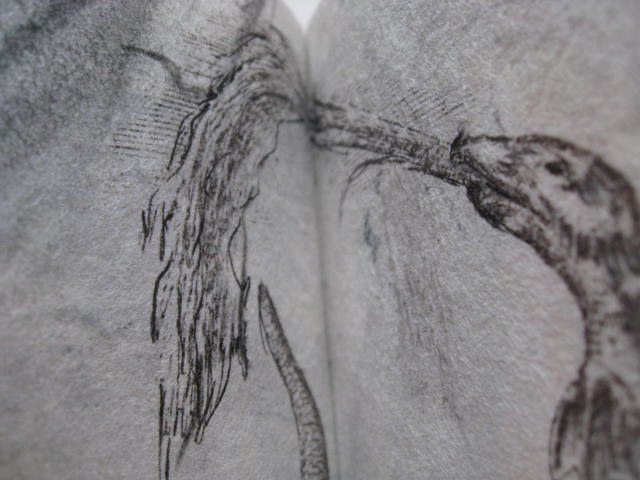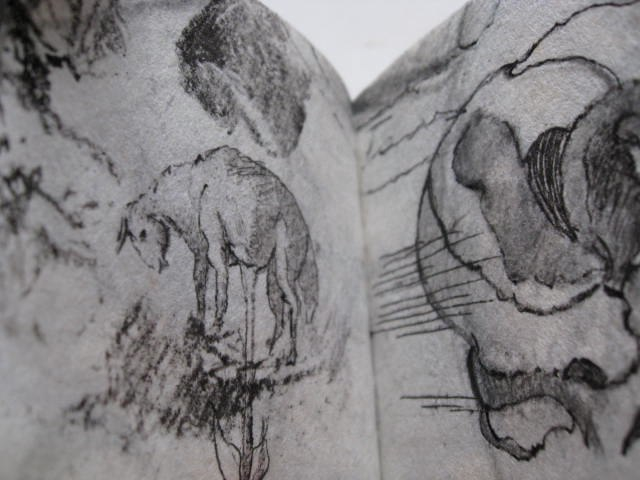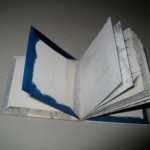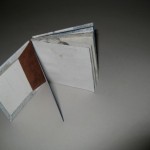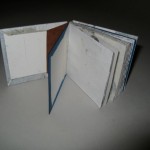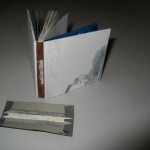This edition of 21 is about specimen collection and presentation, combined with journal type entries about the specimens presented (in this case, things shed by my body). Each day for 21 days I rescued something my body was shedding (eyelash off my cheek) or helped something detach from my body (plucked hair). The specimen was scanned at a magnification of 500%, those scans printed and included in the book pages. The cover of each book holds the specimen itself, sandwiched in between glass for a variable edition of 21 copies.
The concept:
Called upon to participate in an exhibition featuring works created by artists in a regular unit (hourly/weekly/monthly) as part of an ongoing
practice, and realizing that I’m simply not good at keeping up these sorts of regimented projects, I hoped to come up with something I could actually do, without fail, for a sequence of days. I thought, well, aside from what my body does to survive, the only thing I seem able to commit to daily, as on optional and chosen act is drinking coffee. I then considered just what my body does all on its own? Breathes, heart pumps, sleeps, wakes and so forth. I decided to take advantage of my bodies ongoing commitment to regular action in a way that would result in something with physical substance (as opposed to documenting an act, such as breathing).

The process:
I determined a set of rules to govern the project. for 21 days I would collect something created by my body, a little piece of me that was ready to be shed. Those little bits of detritus that flake off when we are sleeping, or are scrubbed off in the shower, or are removed with intent as part of routines rooted in comfort, appearance or hygiene. I did have to help some things along (the hang-nail that needed to be cut, the recurring hair on my jaw that seemingly springs up overnight) but it was more a matter of collection than anything.
Each morning I chose and retrieved my daily specimen, then scanned it at 500% magnification on my flatbed scanner. I had to be careful with some of these very small specimens; I knew an ill timed sneeze could result in an eyelash disappearing without hope of recovery. Happily, I didn’t lose any original specimens. Immediately after the scanning, I placed the specimen between 2 pieces of glass in a glass mounted slide and there they remain.
Then I would write a little something about that day’s specimen. Not yet sure about how the book would be produced, I opted to keep these daily observations pithy. I later settled on the laser etching process for both cutting the pages and ‘printing’ the text and was glad I’d chosen a pithy path.
The production:
In keeping with the idea of cataloging a set of specimens, I labeled each specimen date with a label simulating the typewritten labels I associate with cataloging. They weren’t actually produced on a typewriter though. Mindful of this being an edition work, they were instead laserprinted on rag paper, that I then overcoated with tinted microcrystalline wax. The wax prevents the laser toner from flaking off or ghosting on to another page, the pigment added to the wax ages the paper a bit.
The inkjet printed images I wanted to protect so they were mounted behind a window cut out in each page (similar to older photo album pages). They are labeled by text printed on mylar; the mylar placed over each image before mounting to each page, giving further protection to the photographic images.
Ever interested in using up materials already on hand in the studio, I used a variety of papers (Canson Mi Tiente ‘honeysuckle’ which is close to my own flesh color and maroon unryu for the back side of the pages) leftover from earlier projects. The unryu is a nice choice I think. Its function is to provide a backing to the Canson and prevent text bits with holes in the letters (such as an O, or the round part of a P or D) becoming cut out shapes rather than letter forms.
The text block is bound as a board book, each page consisting of several layers. The unryu makes up the interior of each page ’package’. So the outside, visible, part of each page is a color similar to my own flesh, and the inside, mostly hidden but for the endges and through the cuts on the outside, part of each page is this blood colored paper.
The cover is thick as it needs to accommodate the glass mount slide with specimen.
It is made from 2 layers of Perma-dur corrugated board plus two museum boards cut to hold the slide mount. This ‘package’ is covered with a piece of tanned deerhide suede that has an image of handprint etched into it. The outside edges of the cover are wrapped with this odd bookcloth/paper product that I know little about. It too is maroon in color.
Copies of this book held by University of Washington, Baylor University and University of Denver and private collections. Archive and process materials for this work held by University of Denver, Penrose Library Special Collections. Check on availability in my online store.

















































 I scanned both the negatives and the disintegrating envelopes they were stored in, and printed them via both ink & laserjet. The negatives and prints from the scans are bound wire-edge style.
I scanned both the negatives and the disintegrating envelopes they were stored in, and printed them via both ink & laserjet. The negatives and prints from the scans are bound wire-edge style.









